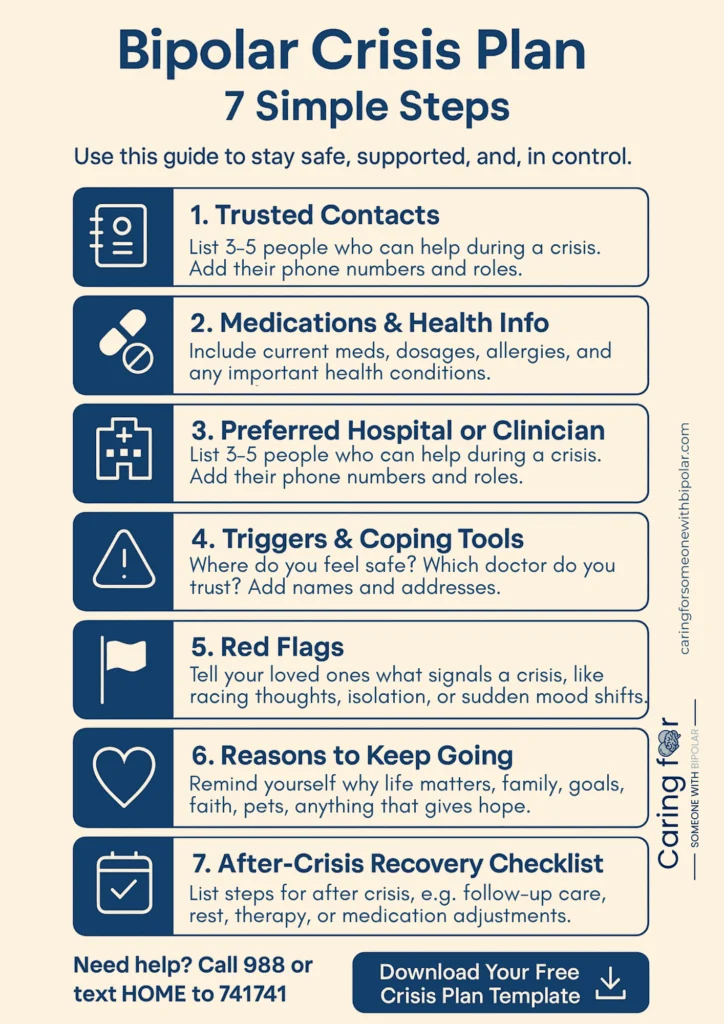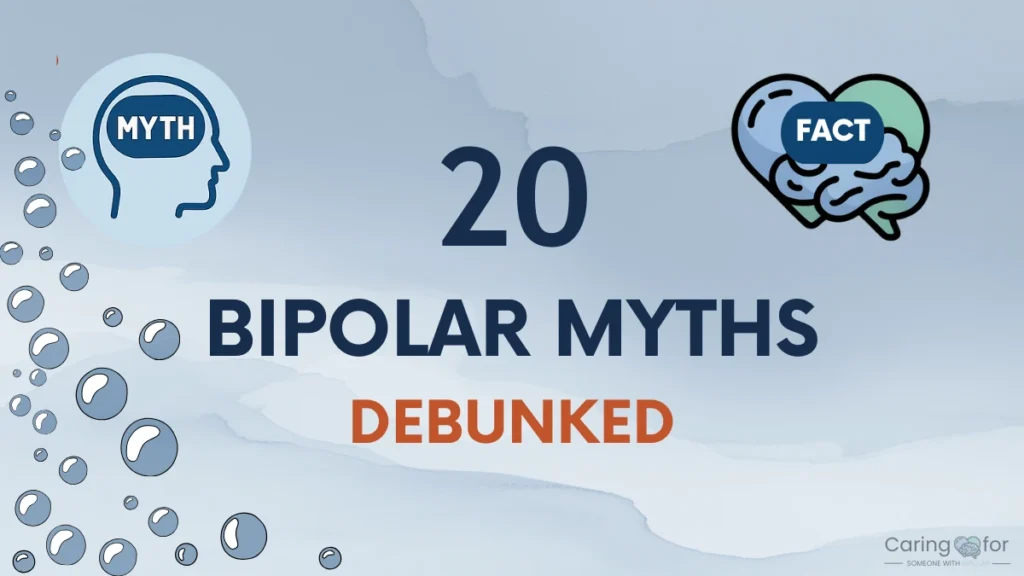When a bipolar crisis hits, a Bipolar Emergency Plan helps you regain control. Whether it’s a sudden burst of energy that won’t quit or a deep low that makes getting out of bed feel impossible, the moment is intense for both the person going through it and everyone around them.
Having a clear Bipolar Emergency Plan makes those moments easier to manage. It gives you a roadmap, tells your loved ones exactly how to help, and makes sure your voice is heard, even when you can’t speak for yourself.

Download Your Free Crisis Plan Template to get started. This simple document can guide treatment choices, protect your safety, and bring clarity when it’s needed most.
What is a Bipolar Emergency Plan and Why It Matters
What is a Crisis Plan?
A bipolar crisis plan is a written guide that tells others what to do when you’re in a mental health crisis. It includes your symptoms, triggers, emergency contacts, medications, treatment preferences, and the steps your support team should take. It speaks for you when you can’t.
This plan helps your loved ones, doctors, and crisis responders take action that respects your wishes and keeps you safe.
Why Every Person with Bipolar Disorder Needs a Plan
- Faster help – People know what steps to take right away.
- Fewer hospital visits – Early action can prevent a full crisis.
- Safer outcomes – You stay protected when you’re most vulnerable.
- Clearer communication – Loved ones aren’t left guessing what to do.
- Peace of mind – You know there’s a plan in place if things go wrong.
Spotting the Warning Signs Early
Recognizing the early signs of a bipolar episode can make all the difference. It gives you and your support team time to act before things get worse. Everyone’s symptoms are a little different, but here are some common ones to look out for.
Signs of a Manic or Hypomanic Episode
- Sleeping less but feeling energized
- Racing thoughts or rapid speech
- Taking big risks or spending too much money
- Feeling overly confident or invincible
- Becoming easily irritated or agitated
- Talking more than usual or jumping between topics
Signs of a Depressive Episode
- Feeling hopeless or numb
- Sleeping too much or not at all
- Eating more or less than usual
- Withdrawing from friends and family
- Struggling to focus or make decisions
- Thinking about self-harm or not wanting to live
Tip: Everyone’s signs are different. Write down your personal warning signs in the crisis plan template. This helps your support network spot trouble early and step in the right way.
What to Include in Your Emergency Plan
A strong bipolar crisis plan should be clear, simple, and personal. It needs to give people the right tools to help you when you can’t help yourself. Here are seven key parts every plan should include:
1. Trusted Contacts
List people you trust to step in during a crisis. Include their names, phone numbers, and how they can help. Think about doctors, therapists, close friends, and family.
Example:
- Dr. Linh Tran – Psychiatrist – (555) 123-4567
- Ava Johnson – Sister – (555) 789-3210
- Local Crisis Team – (555) 000-9988
2. Current Medications & Conditions
Write down all your current medications, including dosages, who prescribed them, and why you take them. Include any allergies and health conditions that others need to know.
3. Preferred Hospital or Clinician
If you have a preferred hospital or want to avoid a certain one, say so. List any mental health professionals you trust, and those you don’t want involved.
4. Crisis Triggers & Calming Methods
What usually sets off a crisis for you? Lack of sleep? High stress? Certain places or people? Write those down. Then list things that help you calm down, music, walks, quiet time, or a favorite routine.
5. Clear Red Flags for Loved Ones
Let others know what behaviors mean you’re in trouble. These are your personal “red flags” like pacing, not eating, or talking fast and loud. When they see these, it’s time to follow your plan.
6. Positive Reminders: Reasons to Keep Going
List the things that matter most to you, your dog, your kids, your art, your goals. These reminders can be powerful in dark moments.
7. After-Crisis Recovery Checklist
What helps you come back to center after a crisis? Include steps like seeing your therapist, adjusting medication, taking a few days off work, or just resting.
Understanding PADs (Psychiatric Advance Directives)
A crisis plan helps others take care of you. A Psychiatric Advance Directive (PAD) gives you legal power over that care—before a crisis happens.
What is a PAD?
A PAD is a legal document that tells doctors and hospitals what you want, and don’t want, during a mental health crisis. It can include instructions about medications, treatments, hospital choices, and who can make decisions for you.
Why It’s Different from a Regular Plan
Unlike a basic crisis plan, a PAD has legal weight. Medical teams are required to follow it, as long as it meets your state’s rules. A PAD lets you make clear choices when you’re well, so they’re respected when you’re not.
How to Make One
PAD laws vary by state. Most states let you name a healthcare agent, list treatment preferences, and say what to avoid.
State-Specific PAD Resources & Legal Help
Psychiatric Advance Directives (PADs) follow different rules depending on where you live. Use the links below to check what’s allowed in your state and how to make it legal.
Visit the National Resource Center on Psychiatric Advance Directives
Choose your state to get forms, instructions, and guidance tailored to local laws.
Need Help Creating One?
You can:
- Ask your therapist, psychiatrist, or caseworker for help
- Contact your local NAMI chapter: Find Local NAMI
- Look for free legal aid in your area via LawHelp.org
Once done, share copies with your support network, doctors, and keep one in your crisis plan folder.
How Loved Ones Can Help During a Crisis
When someone you care about is in a crisis, it’s easy to feel helpless. But with a plan in place, you’ll know what to do, what to say, and how to truly help.
Your Role in the Bipolar Emergency Plan
You’re not there to take over. You’re there to carry out the plan. That means following their wishes, using their calming tools, and making decisions based on what they wrote down when they were well.
Communication “Do’s and Don’ts”
Say:
“I’m here for you.”
“You’re not alone.”
“How can I support you right now?”
“Let’s look at your plan together.”
Avoid Saying:
“Snap out of it.”
“You’re overreacting.”
“This is just in your head.”
“Calm down” (especially in a sharp tone)
De-Escalation Tips
If emotions are high:
- Stay calm. Speak slowly and softly.
- Don’t argue or reason, just listen.
- Offer simple choices: “Do you want to sit or lie down?”
- Reduce noise and distractions.
- Use short, clear sentences.
When to Call for Help (988 vs. 911)
If someone is at immediate risk of hurting themselves or others, call 911. Let them know it’s a mental health crisis so they can send trained responders.
For support without police, call 988, the national Suicide & Crisis Lifeline. They can talk you through the situation or dispatch local mental health help.
Where to Keep and Share the Bipolar Emergency Plan
A well-made plan only works if people can find it when it matters. Make sure your crisis plan is easy to reach in both paper and digital form.
Physical Copies
Print several copies and keep them in smart places:
- Your wallet or purse
- The glove box of your car
- A folder at home in an easy-to-find spot
- Give one to a trusted friend or family member
Digital Backups
Save your plan in places you can access fast:
- On your phone (PDF or notes app)
- In your email or Google Drive
- In a secure cloud storage account
Make sure it’s labeled clearly and easy to find in an emergency.
Who Should Have a Copy
Share your plan with the people who might need it:
- Your doctor or psychiatrist
- Your therapist or case manager
- A close friend or partner
- Any family members listed in the plan
- Your healthcare agent if you have a PAD
Tell them where to find it, and when to use it.
Bipolar Emergency Plan FAQs
Final Thoughts
A bipolar crisis plan isn’t just paperwork, it’s peace of mind. It puts your voice first, gives your loved ones clear steps, and turns chaos into calm when it matters most.
If you haven’t yet, take five minutes now to download your free template. Fill it out, share it, and keep it somewhere easy to reach.

👉 Download Your Free Bipolar Crisis Plan Template
Then share this guide with someone you trust. Your plan could make all the difference.





